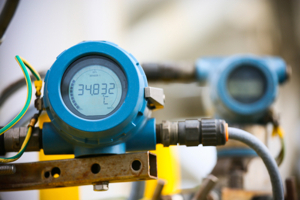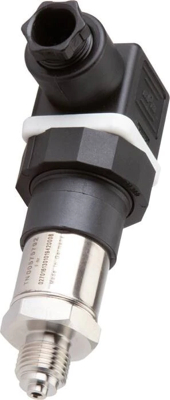Pressure Transducer Selection Criteria

Figure 1: Pressure transducer in oil and gas industry
Selecting the right pressure transducer ensures reliable and precise data acquisition. With many types available, selecting the ideal pressure transducer can be complex. It is crucial to consider different parameters such as pressure range, accuracy, media compatibility, and environmental conditions. This article explores these parameters in detail to help the user make an informed decision while selecting a transducer. Read our pressure transducer article for more details on how the device works.
Selection criteria
- Pressure range
- Connection size and voltage
- Linearity
- Process media
- Output type
- Application and measurement type
- Temperature range
- Accuracy
- Resolution
- Response time
- Installation environment
- Design features
- Maintenance
- FAQs
View our online selection of pressure transducers!
Pressure range
It's crucial to determine a pressure transducer's range. The range refers to the maximum and minimum pressures the transducer can accurately measure. There are two main parameters to consider when selecting the range:
- Accuracy: The range should be low for the best accuracy (discussed later), with the normal operating pressure falling somewhere in the middle of that range.
- Overpressure protection: Considering what could happen if the pressure goes beyond the normal operating range due to errors, design flaws, or testing mistakes is crucial. To safeguard against this, it's essential to specify the amount of overpressure protection needed, ensuring the transducer can handle pressures beyond the normal range without getting damaged.
Example
Consider choosing a transducer for a hydraulic system that operates at 2000 psi (137.8 bar).
- Accuracy: Choose a pressure transducer with a range centered around this 2000 psi (137.8 bar) for optimal accuracy. For instance, a transducer ranging from 1500 psi (103.4 bar) to 2500 psi (172.3 bar) would provide an accurate reading for the typical operating pressure. This is because the operating pressure is in the middle of the transducer's range, where it can best detect and measure changes in pressure.
- Overpressure protection: It's essential to consider what might happen in an abnormal situation, for example, if a valve gets stuck and causes the pressure to surge to 3000 psi (206.8 bar). The transducer should handle this overpressure situation without getting damaged. A transducer with adequate overpressure protection, say up to 4000 psi, is a good choice.
In this case, the ideal pressure transducer for this system might range from 1500 psi to 2500 psi for optimal accuracy and overpressure protection up to 4000 psi.
Connection size and voltage
The connection size determines how the transducer fits into the system. It's important to ensure compatibility with existing components and a secure and leak-free connection. Choosing a transducer with the appropriate voltage range ensures proper operation and integration with your power supply system. Ensure the transducer's measured thread size matches the equipment or fittings to avoid leaks and ensure a reliable connection.
Linearity
Linearity in pressure transducers refers to the ability of the device to produce an output that is directly proportional to the input pressure. In simpler terms, if the pressure is doubled, the output of the transducer should also double, assuming perfect linearity. However, in practical applications, there can be a small amount of non-linearity between the input and output readings. For example, a non-linearity between 0.2 to 0.5% means that the measured values may be off by up to 0.5% of the total measurement range.
Process media
The parts of the pressure transducer that come into direct contact with the process fluid are known as 'wetted parts.' The transducer's wetted parts should be compatible with the media used. Common process media considerations include:
- Compatibility: Choose materials compatible with the specific process fluid to avoid corrosion or contamination.
- High nickel alloys: For corrosive fluids like seawater, consider using high nickel content alloys for their excellent corrosion resistance.
- Stainless steel:Stainless steel 304 and 316 and 17-4 are common for pressure gauges in various applications due to their corrosion resistance and strength.
- Sanitary fittings: Hygienic industries (such as food, beverage, and pharmaceuticals) use pressure transducers with sanitary fittings to ensure cleanliness and prevent bacterial buildup. The sanitary fittings allow the transducer to be quickly and easily cleaned, either by being disassembled manually or through an automated cleaning process.

Figure 2: Stainless steel pressure transducer
Output type
Pressure transducers can have different outputs, each offering unique features and advantages:
- Ratiometric output: The output signal changes proportionally to the power supply. It's beneficial when the system's power supply isn’t stable, as it helps to maintain output accuracy.
- mV/V output: This is a millivolt per volt output. It is the simplest and cheapest output option and is unamplified, meaning it provides a raw signal directly from the sensing element. This output type is suitable for short-distance transmissions and is often used in controlled environments.
- Amplified voltage output: Some pressure transducers have built-in amplifiers to increase the output signal level. This makes the signal robust against electrical noise and allows it to be transmitted over longer distances.
- mA output: Current output, typically 4-20 mA, is used when the signal needs to be transmitted over long distances. This is because current, unlike voltage, does not degrade over distance. This type of output is common in industrial applications.
- Digital outputs: Some pressure transducers provide a digital output, which can be directly interfaced with a computer or other digital systems.
Application and measurement type
Choosing the right pressure measurement type for a pressure transducer largely depends on the specific application and needs of the system it will use. Common pressure measurement types include:
- Absolute: This type of pressure measurement is referenced against a perfect vacuum. It measures the total pressure exerted by the fluid, including atmospheric pressure.
- Gauge: Gauge pressure is referenced against the ambient atmospheric pressure. It measures the pressure above or below the local atmospheric pressure.
- Differential: This measures the difference in pressure between two points within a system. This is useful when the pressure difference, rather than the absolute or gauge pressure, is critical.
- Vacuum: Vacuum pressure refers to the amount of pressure below atmospheric pressure. It is used in suction devices or situations requiring reduced pressure.
- Bidirectional: Bidirectional pressure transducers can measure positive and negative pressures (above and below atmospheric pressure). This is necessary in systems where pressure can fluctuate in both directions from a reference point.
Read our atmospheric, absolute, gauge, and differential pressure article for more information on different pressure types.
Temperature range
Ensure that the pressure transducer is suitable for the temperature range of operation. Transducers made of thin film technology work superior under high temperatures. The thin layers of material (such as metal or semiconductor) withstand high temperatures better than other technologies because they are less likely to expand, contract, or degrade under extreme heat.
Extreme temperatures can create errors in a transducer's output, often expressed in percent full scale over 1°C (%FS/°C). For example, if a pressure transducer has an error rate of 0.2% full scale per degree Celsius (%FS/°C) and the temperature increases by 10°C, the output could deviate by 2% of its full scale, affecting the accuracy of pressure measurements.
Accuracy
The pressure measurement accuracy of a pressure transducer refers to how close its measurements are to the actual pressure being measured. For example, if the transducer has a full-scale range of 0 - 6.9 bar (0 to 100 psi), and its accuracy is 0.5% of the full-scale output, it means that the device's measurements could deviate by up to 0.03 bar (0.5 psi) from the true pressure reading at any point within its range.
In many standard applications, a pressure gauge with 0.5% accuracy is sufficient to provide reliable measurements. However, higher accuracies are desired in certain critical applications involving low pressures (like aerospace, pharmaceuticals, or semiconductor manufacturing) where accurate pressure readings are essential.
Resolution
Resolution of a pressure transducer refers to the smallest amount of change in pressure that the transducer can detect. For example, if a pressure transducer has a full scale of 100 psi and a resolution of 0.1%, it could detect changes as small as 0.1 psi. The resolution of a pressure transducer is crucial as it dictates the accuracy of measurements. High-resolution transducers are needed for precise readings, while lower resolution suffices for general detection. The need for resolution depends on the application, and costs may be higher for higher-resolution transducers.
Response time
The response time is the time it takes for the transducer to react and output a signal when pressure changes. It's important because it affects the accuracy and speed of pressure detection. When selecting a transducer, fast response times are needed for real-time monitoring (like a medical ventilator), while slower ones may be sufficient for gradual pressure changes and can be more cost-effective.
Installation environment
Corrosion and exposure to explosive vapors are two significant factors that can affect the performance and safety of transducers.
- Corrosion: Splashing of corrosive liquids or exposure to corrosive gasses on the surface of the housing.
- Explosive vapors: If the installation area involves explosive vapors, the transducer and its power supply should be suitable for these environments. For this, they are usually placed inside explosion-proof housings or by intrinsically safe designs. In intrinsically safe designs, the amount of power available to the electrical equipment in the hazardous area will be set to a level below that which will ignite the gasses.
Design features
Special versions of pressure transducers with flush diagrams are available for applications involving viscous or particle-laden media. Flush diagrams incorporate a small orifice that allows a continuous flow of fluid to pass across the transducer's sensing element, effectively cleaning it and preventing the buildup of debris or contaminants. This feature is particularly beneficial in food processing, pharmaceuticals, and chemical manufacturing industries. Pressure transducers with food-grade liquid fill are specifically designed for food and beverage applications. These transducers utilize a fill fluid that is inert and compatible with food products, ensuring the integrity and safety of the food being processed.
Maintenance
Choosing pressure transducers with self-calibration features or easy calibration procedures can reduce maintenance requirements and downtime. Choosing durable and stable transducers can also minimize the need for frequent maintenance, ensuring consistent performance over time.
FAQs
How does the accuracy of a pressure transducer affect its selection?
Accuracy is crucial as it determines how close the measured value is to the actual value. Higher accuracy is needed for critical applications like aerospace and pharmaceuticals.
Why is the pressure range important in choosing a pressure transducer?
The pressure range ensures the transducer operates within its limits. Selecting a transducer with a suitable range prevents damage and inaccurate readings.





